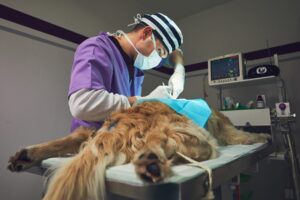
If your veterinarian has recommended a Tibial Plateau Leveling Osteotomy (TPLO) surgery for your dog, you may have a few questions.
If your veterinarian has recommended a Tibial Plateau Leveling Osteotomy (TPLO) surgery for your dog, or you are looking into it as an option, you may have a few questions. It can be a scary experience when your pet hurts themselves and needs major surgery. However, it helps to educate yourself as much as possible about the injury, surgical procedure, and recovery process. Let’s go over what to expect when your dog needs TPLO surgery.
What is TPLO Surgery?
A dog’s CCL (cranial cruciate ligament), which is comparable to a human’s ACL in their knee, can deteriorate or weaken over time for various reasons. It is also one of the most common places for traumatic injury in canines. Because the CCL degenerates over time, it can tear with relatively minor trauma, especially in a dog with a very steep tibial plateau. This is known as a pathological tibial plateau angle. A rupture of the CCL is the leading cause of lameness of the hind limbs and can cause instability in the knee joint. TPLO surgery is often recommended for repair, as it restores them closer to normal function. Unlike other surgeries, TPLO restores your dog’s knee mobility without relying on the damaged ligament for stability.
What to Expect During Surgery
The TPLO surgery produces functional stability of the knee by flattening the tibial plateau slope. Your surgeon will make a curved cut to the tibia before rotating the top section to level the tibia and femur. The goal of this is to prevent the femur from sliding down the tibia slope and helping to stabilize the knee. Once the plateau is in the correct spot, the surgeon will then attach a metal plate to stabilize the knee as it heals around the new arrangement.
What to Expect During Recovery
Once you bring your dog home after surgery, make sure they have a quiet place to rest, preferably in a semi-secluded room where they will not be disturbed. Use safety gates to prevent access to stairs and long hallways and close exterior doors. Be sure to follow all of the veterinarian’s post-op instructions to keep your dog safe. You must restrict your dog’s activity level to short leash walks as directed by your surgical team. This means no running, jumping on/off of furniture, or roughhousing. Ensuring your pet is fully healed before resuming normal activity or rough play is vital to prevent further complications.
Trust Maryland Veterinary Surgical Services With Your Companion’s Health
Your companion’s health is important, and the team at MVSS is ready to provide the best care possible for your furry family. We are dedicated to combining comprehensive exams and assessments with informative and honest discussions of your companion’s care. Once we have worked with you to decide on the best course of action for your dog, our professionals will use their surgical expertise to work towards the goal of giving your companion an active and pain-free life. We are proud to serve loyal companions in Catonsville and Baltimore. To learn more about our services, give us a call at 410-788-4088 or visit us online. For more information and tips for pet health, follow us on Facebook and Pinterest.
